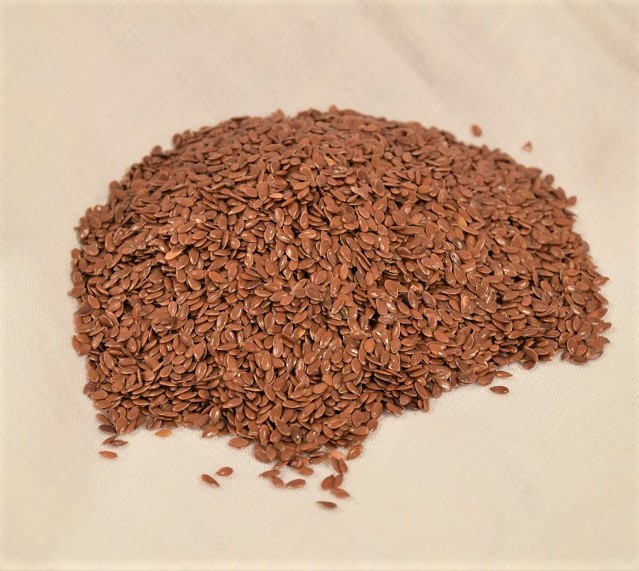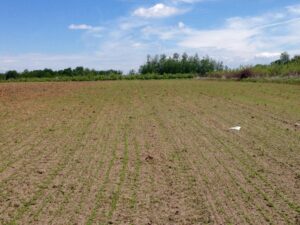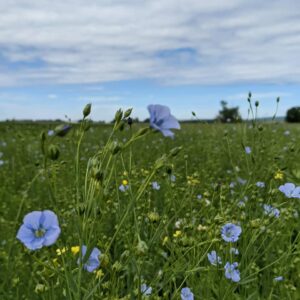
05 May TapRoot Flax Seeding Suggestions
This year at TapRoot we have sourced seed from Fibrevolution in Oregon. They have a growing guide on their website. FIBREVOLUTION FLAX GROWING GUIDE – check it out. The seed variety is Linore.
We have flax seeds available for purchase within Canada at our mill or our online shop. If you wish to purchase flax seeds in the USA please contact Fibrevolution and they can sell you long line linen flax seeds.
The following seeding suggestions are taken from a section out of Josh’s Nuffield Report: From Seed to Shirt: Flax to Linen in Canada for the Local and Global Market, page 19. You can read the full report here.

Emerging Flax in 2015 at TapRoot Farms
Everyone can grow flax for linen. You can grow a handful in your flower garden or a large field.
Seeding method: seed drill or broadcasting (as even and uniform as possible)
Seed depth: 2 cm
Row spacing: 12.5 cm
Seeding rate: ~ 1800 – 2200 seeds per m2 or ~ 120lbs -150lbs per acre
Planting time: as soon as possible in the year up until mid May (flax can handle cold wet frosty spring)
Days to maturity: for fibre approximately 90 days depending on the variety
Nutrients required: We suggest you have a current soil sample to help guide what is required. We understand between 25 – 90 kg/hectare of nitrogen, 40kg/ hectare of phosphorus and 140kg/ hectare of potassium may be required by the flax. It is suggested that a zinc application will assist in increased yield. At TapRoot we work with a crop fertility consultant. They are able to help us provide appropriate nutrients to the various crops while considering the nutrients within various amendments including manure and composts and currently available in the soil.
Weeding: by hand, you need to get in early so you do not pull out the flax when weeding. If weeding with herbicides, the availability of products is low with only pre-emerge or early growth stage applications available, leaving a small window of opportunity for control.

Flax in bloom.
Disease: Flax is sensitive to soil-borne diseases like fusarium, so the rotation is long. The recommendation is 6 years between flax plantings.
Enjoy seeding and watching your flax grow. We would love to follow along on your flax growing journey. We will be sharing as well. We invite you to use #flax2023 as a way for us to connect with each other and share as our flax grows.
You may be interested to join the Facebook group: Flax to Linen.
We invite you to follow Jennifer Green’s exciting flax adventure here in Nova Scotia: The Flaxmobile Project. @flaxmobile on Instagram.
May the flax growing begin.
Prepared by Patricia May 5, 2022.
May 2023. Contribution by Alvin Ulrich from Biolin Research Inc in Saskatoon, SK . Thanks Alvin@
In western Canada, where most of Canada's oilseed flax is grown, there
are quite a few herbicides registered and available for use in flax.
(google, for example, "Flax on the Farm" at www.saskflax.com and
"Integrated weed management in flax" at www.topcropmanager.com). They
may or may not be available in other parts of North America, not because
they don't exist or because they are not registered, but because the
market for them is too small to justify a local dealer outside of
western Canada to carry them. I suspect local dealers could get them if
people knew what they were and ordered them a few months ahead of time.
Sometimes recommendations for actual nitrogen for oilseed flax seed
production can be as high as 90 kg/ha (i.e., if urea were used the it
has 33% actual nitrogen so to get 90 kg of actual nitrogen, you would
have to apply 90/.33 or 273 kg of urea/ha). I have found that if you
want a high percentage of strong flax fiber, its is best not to go over
5o kg/ha of actual nitrogen. A couple times we exceeded this rate
because farmers didn't soil test and planted it on corn stubble or used
the rate they use for seed production. Then it rained a lot during the
summer, and the flax lodged (half laid down) and the stems were very
dark green, soft and "lush". It was tangled and very hard to pull with
a flax puller. After drying and retting the fiber content was
relatively low (e.g., 20% instead of 30%). I have found that, in the
summer, if the fiber flax, looks pale green and you say to yourself,
"oh, it's lacking nitrogen", that, is in fact, the ideal amount of
nitrogen (e.g. 40 to 50 kg/ha) for fiber production to get a high yield
of long and strong fiber.